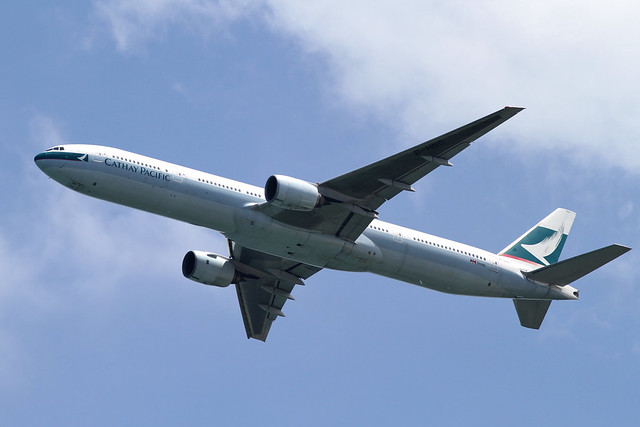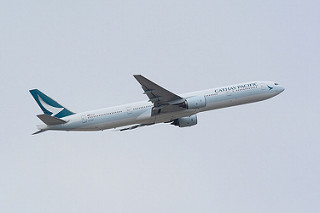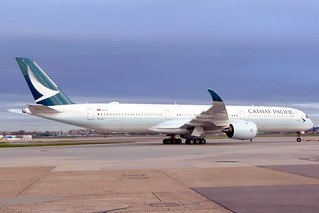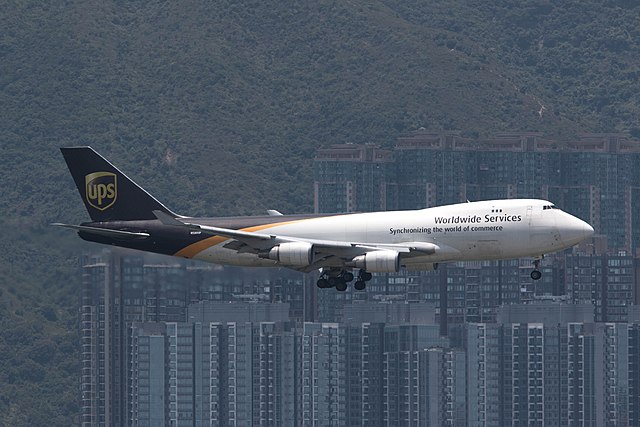Cathay Pacific A359 near Hong Kong on Feb 21st 2019, captain incapacitated
Last Update: August 23, 2023 / 18:35:15 GMT/Zulu time
Incident Facts
Date of incident
Feb 21, 2019
Classification
Incident
Cause
Captain incapacitated
Airline
Cathay Pacific
Flight number
CX-170
Departure
Perth, Australia
Destination
Hong Kong, China
Aircraft Registration
B-LRR
Aircraft Type
Airbus A350-900
ICAO Type Designator
A359
Hong Kong's AAIA released their preliminary report rating the occurrence a serious incident and opened an investigation.
On Aug 23rd 2023 the AAIA released their final report concluding the probable cause of the incident (reclassified as incident instead of serious incident) was:
The Captain experienced difficulty in breathing, loss of visual acuity, dizziness, headache, and chest pain and the situation continued to deteriorate.
The AAIA stated with respect to the medical aspects:
Both the CN and the FO were compliant with the medical requirements to hold an ATPL.
The CN had sufficient rest before conducting the flight.
After conducting a walkaround check in Perth, the CN felt out of breath but recovered after a short period of time. After about an hour enroute, the CN felt shortness of breath again. He then used an oxygen mask to breathe 100% oxygen for 10 to 20 seconds and felt better. He later put on the oxygen mask again.
Both the CN and FO conducted periods of inflight rest.
At approximately 0530 hrs and around 20 minutes from the ETP between Manila and Hong Kong and in the Manila FIR, the CN started to feel worse again. He experienced difficulty in breathing, loss of vision acuity, dizziness, headache, and chest pain. He told the FO that "l am not feeling good and getting worse. I am incapacitated." The FO then called the Inflight Service Manager (ISM) to the cockpit for assistance.
After the ISM entered the cockpit, the CN was well enough to tell her his condition. He later declared incapacitation and handed over the control to the FO.
The FO contacted MedLink of the Aviation Medical Office (AMO)6 and they advised the CN to use oxygen and have sugary drinks.
The SP in the cabin made a PA call to ask if there were any doctors on board. A medical doctor passenger came forward and offered help in the cockpit. After communication between the doctor passenger and MedLink, the CN was given several different medicines. The doctor passenger remained in the cockpit for landing to monitor the CN’s condition.
The CN took the medication and felt better. He remained conscious for the remaining flight. According to the FO, the CN was not fully incapacitated and “could speak about 60 to 70%”.
The CN had no medical history regarding this symptom.
After the event the CN was temporarily removed from duties until he could obtain medical clearance to resume flying.
The AAIA analysed:
After the CN’s condition deteriorated again, he declared incapacitation and handed over the control to the FO. The FO took out the Crew Incapacitation checklist in the QRH and ran through it. The FO called the operator’s Integrated Operations Centre (IOC), advised them of the situation, and asked for medical support on arrival. The FO had an early opportunity to maintain control of the aircraft, take care of the CN, re-organise the flight deck work, and land the aircraft.
When the CN declared he was incapacitated, the FO was the PF and the autopilot system was kept engaged. There was no immediate threat to the control of the aircraft. Optimal use of the autopilot is mandated by airlines as SOPs and is also one of the steps in Pilot Incapacitation checklist in the Abnormal and Emergency Procedures. The autopilot system could also autoland the aircraft if required.
At this point the aircraft was closer to Manila than Hong Kong by around 20 minutes. The CN remained conscious and was able to talk to the FO. After discussion and consideration of the CN’s medical situation, flight phase, aircraft conditions, meteorological conditions, time taken for negotiating a re-clearance with Manila ATC versus expected timely response from and priority given by ATC at the home port, single pilot operation, etc., the FO’s assessment of the contingency options and the decision to continue to the familiar home port is considered appropriate.
The FO used the electronic checklists as per the SOP with the SP available to read out the printed checklist if required, as he considered that the electronic checklists were easier to access, search and follow. By having checklists available at the touch of a button, crewmembers, when faced with unexpected situations, have the proper checklists for emergency procedures available.
ATC prioritised the approach of the flight and instructed them to descend for a high speed approach to Hong Kong. ATC also cleared the aircraft to descend early for a lower cabin altitude which might help the CN to breathe. The communication of the flight with the enroute and terminal ATC units was effective.
There was no evidence indicating that the FO had any difficulty in dealing with the situation and continuation of the flight. Adhering to the SOP and making the best use of the assistance and resources from ATC, cabin crew, and aircraft automation reduced the complexity and workload for the FO.
The FO used the appropriate level of automation and decided to conduct a manual landing with autothrust over an autoland as it was the most familiar to him. The aircraft was landed safely and taxied to the arrival gate with no further events.
The flight crew and cabin crew complied with the operational aspects of company procedures, policy, and guidance during the descent, approach, and landing.
Incident Facts
Date of incident
Feb 21, 2019
Classification
Incident
Cause
Captain incapacitated
Airline
Cathay Pacific
Flight number
CX-170
Departure
Perth, Australia
Destination
Hong Kong, China
Aircraft Registration
B-LRR
Aircraft Type
Airbus A350-900
ICAO Type Designator
A359
This article is published under license from Avherald.com. © of text by Avherald.com.
Article source
You can read 2 more free articles without a subscription.
Subscribe now and continue reading without any limits!
Read unlimited articles and receive our daily update briefing. Gain better insights into what is happening in commercial aviation safety.
Send tip
Support AeroInside by sending a small tip amount.
Related articles
Cathay Pacific B773 at Hong Kong on Apr 1st 2024, suspected hydraulic problem, air conditioning problem
A Cathay Pacific Boeing 777-300, registration B-HNG performing flight CX-504 from Hong Kong (China) to Tokyo Narita (Japan) with 432 passengers and…
Cathay Pacific A35K enroute on Dec 11th 2023, captain felt unwell
A Cathay Pacific Airbus A350-1000, registration B-LXM performing flight CX-101 from Hong Kong (China) to Sydney,NS (Australia), was enroute at FL390…
Cathay Pacific B773 near Hong Kong on Jan 26th 2019, captain incapacitated
A Cathay Pacific Boeing 777-300, registration B-HNP performing flight CX-583 from Sapporo (Japan) to Hong Kong (China) with 348 passengers and 16…
Cathay B773 at Hong Kong on Jun 24th 2023, rejected takeoff due to disagreeing airspeeds
A Cathay Pacific Boeing 777-300, registration B-KPQ performing flight CX-880 from Hong Kong (China) to Los Angeles,CA (USA) with 293 passengers and…
Cathay Pacific A35K near Hong Kong on Mar 28th 2023, hydraulic failure
A Cathay Pacific Airbus A350-1000, registration B-LXJ performing flight CX-178 from Melbourne,VI (Australia) to Hong Kong (China), was descending…
Newest articles
Delta B763 at New York on Apr 26th 2024, emergency slide trouble
A Delta Airlines Boeing 767-300, registration N176DN performing flight DL-520 from New York JFK,NY to Los Angeles,CA (USA), was climbing out of JFK's…
UPS B744 at Tokyo on May 6th 2023, hard touchdown on windshear recovery
A UPS United Parcel Service Boeing 747-400, registration N580UP performing flight 5X-109 from Shanghai Pudong (China) to Tokyo Narita (Japan), was on…
Subscribe today
Are you researching aviation incidents? Get access to AeroInside Insights, unlimited read access and receive the daily newsletter.
Pick your plan and subscribePartner

A new way to document and demonstrate airworthiness compliance and aircraft value. Find out more.

ELITE Simulation Solutions is a leading global provider of Flight Simulation Training Devices, IFR training software as well as flight controls and related services. Find out more.

Your regulation partner, specialists in aviation safety and compliance; providing training, auditing, and consultancy services. Find out more.
AeroInside Blog
Popular aircraft
Airbus A320Boeing 737-800
Boeing 737-800 MAX
Popular airlines
American AirlinesUnited
Delta
Air Canada
Lufthansa
British Airways







